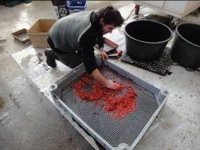News
2014-02-24
Innovation in seed extraction and transplant
Seed extraction and transplant at the Seed Office in Marche-en-Famenne (Luxembourg province, Belgium)
This news focus on 2 of the actions scheduled by the LIFE ELIA team : the creation of forest edges and the conservatory plantations of wild trees under overhead electrical lines.
On January the 30st, 3 members of the LIFE ELIA team achieved 2 major tasks :
- seed extractions from fruits harvested between November and December 2013
- transplant of cornelian cherry dogwood (Cornus mas)

From fruits to seeds
Fruits harvested were collected on wild apple tree (Malus sp), cranberry bush (Viburnum opulus), cornelian cherry dogwood (Cornus mas), blackthorn (Prunus spinosa), elder (Sambucus nigra), hawthorn (Crataegus sp.), privet (Ligustrum vulgare) were originated from trees located in the surroundings of Doisches (Namur Province, Belgium) and Saint-Hubert (Namur Province, Belgium). A batch containing 25 kg of wild apples from Brittany (France) was also processed.
Once the dormancy breaking of the grape seeds occurs, they will be sent to the nursery to be further planted under overhead electrical lines in the surroundings of Brasparts (Finistère Department, France).
According to species, different extraction techniques were used : grinding, crushing, stamping, floating and high-pressured water. Seeds collected were then stocked in fridges of the Seed Office. The seed dormancy and plantation will be therefore controlled and planed in a few months.

A promising plant shoots transplant
On the other hand, the team also transplanted 200 cornelian cherry dogwood plant shoots which will end up being planted in our edges areas in Autumn 2014.

Working towards diverse edges for biodiversity
Fruits harvesting, seed extraction, seed conservation and planting are all steps leading to the creation of edges diversified in terms or flowers and fruits. And these actions have to be done in accordance with biological cycles of the different species. For each of them, many factors can vary : dormancy breaking, multiple manipulations, heat, cold, humidity. It represents a heavy work all put together, but it will ensure a large success when planted on the field.
Eventually, these diversified edges will contribute on a long-term establishment of biodiversity all along the electrical transport network. Since it really plays a role of green corridors, this network has to be seen as a great potential for the moving of many species.

